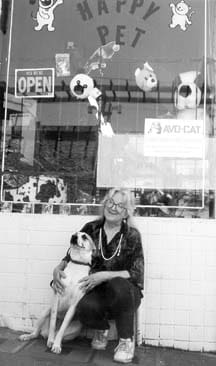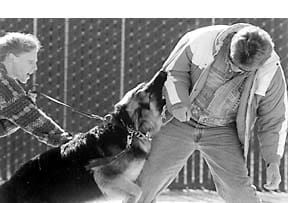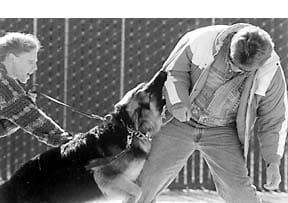Good holistic health care fulfills the needs of the whole animal being, physically, mentally, and emotionally. A sound, well balanced diet (along with fresh, clean water), appropriate exercise, and proper behavioral education just about covers the bases.
Or does it? Health is individual. Many people consider their animals to be healthy as long as they aren’t sick, but to me, a healthy dog is happy and expressive, exuding resilience. Whether our animal companion denotes health with a gleaming eye, a flashing coat, and an athletic leap for a Frisbee, or a half cocked ear, sly grin, and thumping tail from the Barcalounger, we can best ascertain the level of our friends’ health by observing over time what’s normal for each unique individual.
Healthy animals can and do get sick occasionally. Sometimes a “tincture of time” is the best remedy, as the dog’s body fights off an invading bacteria or virus and the “illness” resolves with the passing of time. Occasionally, you’ll need veterinary help for a pet’s acute or severe problem. But in other times, a minimal treatment provides a sufficient level of care to boost the healing response. That’s where herbal treatments shine.

Why should dogs have herbs?
Plants provide vital natural sources of vitamins, minerals, and trace elements that many of today’s commercial diets just don’t provide, what with poor-quality and over-processed ingredients. And in our increasingly urbanized environment, many dogs don’t have the opportunity to forage and ingest healing plants they instinctively seek out when feeling distressed.
From herbal treatments, animals can derive not only nutritional benefits, but also gentle, non-invasive medicinal therapy. Herbal medicine works by strengthening the body’s physiological systems, rather than treating only individual presenting symptoms. Because our culture is so accustomed to the methods of reactive, allopathic medicine, it’s easy to view herbal remedies as simply replacements for pharmaceutical drugs, but this is a mistake. Herbs aren’t a quick fix in the way drugs often are. Instead, they are usually gentler and slower-acting.
Below, we describe several common canine health problems that can often be quickly and easily remedied with herbal treatments. Even though herbs often serve as the raw material for refined and standardized prescription drugs, you’ll find some variance in the relative strength of plant materials, as well as products prepared in the same manner from different lots of herbs. For that reason, your approach to using herbs should be flexible. Monitor your dog’s behavior and symptoms, and be prepared to increase or decrease the amount you use accordingly.
There may not be one right method of herbal administration for your dog (or you!) but with patience, you may find the right combination of herbal treatments that will support growing wellness in your animal companion.
Arthritis
Just as in people, arthritis is probably the most common chronic health condition in older dogs. It is characterized by chronic inflammation and calcium deposits in the joints, leading to stiffness, swelling, and pain.
A classic herb tea for arthritis uses equal parts alfalfa, burdock, and white willow. The first two are excellent detoxifiers, and white willow is an effective anti-inflammatory and pain relieving agent. In addition, alfalfa is full of nutrients. This is best administered as a tea, mixed in with the dog’s food or water. The liquid has a pleasant taste, but if a dog refuses it, squirt a teaspoon of the mixture into his mouth two or three times a day.
Given that it is such a common condition, it’s a cinch that a number of herbal treatments have been recommended by veterinarians and herbalists. Dr. Richard Pitcairn, a well-known holistic veterinarian and author of “Natural Health for Dogs & Cats”, suggests adding one to three tablespoons of alfalfa to the daily diet, or using the herb in a tea. Juliette de Bairacli Levy, author of “The Complete Herbal Handbook for the Dog and Cat,” suggests feeding raw comfrey and chopped parsley in the dog’s food, and rosemary or nettles tea.
Herbalist Diane Stein, author of “The Natural Remedy Book for Dogs & Cats,” recommends feeding garlic to reduce arthritic symptoms. She suggests other herbs can be used for specific properties, according to their role in the individual’s arthritis. Yucca can be used for its steroid and pain-relief properties. Licorice root can display anti-inflammatory action. Horsetail grass contains silica and aids calcium absorption. For pain relief, Stein recommends valerian root, skullcap, St. John’s Wort, chickweed, or feverfew.
Diarrhea/Gastritis
Diarrhea is a symptom rather than a disease. Diarrhea with no other symptom in an adult dog can be safely allowed to continue for a day or two, as the process works to rid the body of causative agents. However, a dog with diarrhea accompanied by abdominal distention, projectile vomiting, dehydration, fever, or respiratory symptoms, should be seen by a veterinarian as quickly as possible. If the stool contains blood or is black and tarry, there may be intestinal tract bleeding; seek immediate veterinary attention. Puppies suffering from diarrhea also need expert attention – dehydration can quickly result in death to vulnerable pups.
Diarrhea can be caused by many agents or conditions. Toxins from flea collars or dips can cause diarrhea and vomiting. In this case, wash the dog with soap and water and remove the collar.
Sometimes animals eat plants that cause diarrhea to rid their bodies of wastes. Once the animal has removed the causative factor from its system, or toxin been removed, the diarrhea usually stops.
Diarrhea is often the result of your dog eating something laden with bacteria, such as spoiled food or dead animals. If you know your dog has eaten something he shouldn’t have, and suspect that as the main cause of his diarrhea, your first treatment should be to withhold his regular food until the diarrhea has run its course. Then give him one half to one teaspoon of slippery elm syrup or powder mixed with honey or water, three times a day for three days.
Unbeknownst to many people, the same bacteria that necessitates the use of water filters or purification tablets in the mountains (giardia) can cause diarrhea in dogs. If your dog has had the opportunity to drink from rivers or streams that may be infected by giardia, or if you are traveling far from home and the water may contain unfamiliar bacteria, goldenseal can be used to combat the resultant diarrhea.
Ear Infections
Head shaking, pawing, or scratching at the ears, a foul odor, brown discharge, and redness or swelling inside the ear flap all indicate infection. The causative agents may be a foreign body (tick, foxtail), bacterial or fungal infection, or even ear mites (these are usually not common to dogs, but are contagious to those dogs living closely with infected cats). A veterinarian’s inspection with an otoscope, and perhaps a slide prepared with a smear of the dog’s offending ear exudate will offer clues as to the source of his discomfort and subsequent treatment. Foreign bodies may require removal by your veterinarian.
Many flap-eared dogs have hair growing in the ear canals. Trimming this hair will help air flow and facilitate drying after bathing or swimming. A clothespin can be used periodically to hold back the ears of long-haired dogs (take care to close the pin on the long hair, not the tender ear flaps) to expose the insides of the ears to air and help heal infections.
To clean ears, make a solution of half witch hazel, half water, or half hydrogen peroxide and half water, wiping out the ear canal gently with cotton balls.
Mullein and garlic ear oil, readily available from health food stores, works well to clear up infections and reduce excessive ear wax. Clean the ear canal of discharge and wax daily before administering. This is especially useful when the infection is caused by yeast or fungus that is proliferating in the presence of chronic wetness inside the ears. Make sure you refrigerate garlic oil after it has been opened. Botulism spores can proliferate in garlic oil at room temperatures.
Another approach, recommended by Wendy Volhard and Kerry Brown, DVM, co-authors of “The Holistic Guide for a Healthy Dog,” is to use a mixture of echinacea and goldenseal as a tincture after cleaning the ears. That mixture, as well as grapefruit extract, has anti-fungal properties that can help eliminate stubborn infections. Each of these are slightly caustic, so dilute the mixtures if the ears are inflamed.
Flea Allergy Dermatitis
The misery induced by flea infestations peaks with the mercury – summer is high season in the flea world. Incessant itching, scratching, and resultant “hot spots” can drive your dog and you crazy. If your dog has fleas, keep in mind that probably only one tenth of the fleas present are on the animal – the rest are in the carpet, in the upholstery, and in the yard, breeding more fleas. (To get the situation under control, see “Flee, Evil Fleas.”)
The itching, scratching, and resultant damage to the skin and coat caused by irritating flea bites are easily treated with a soothing tea comprised of equal amounts of fresh or dried calendula, nettle, red clover, rosemary, and yarrow brewed as a strong infusion that steeps for eight hours or so. If the herbs are fresh, use as much as a handful for each cup of water. Use one to two tablespoons of each dried herb per cup of water. Apply the cool tea to the affected area with a cloth or just pour it on directly as a rinse, repeating the application every few hours. This tea is so cooling and so healing that it reduces inflammation right away.
Comfrey can also help soothe skin problems of all sorts. The fresh or dried herb, or a comfrey tea or tincture can be added to the dog’s food; the latter liquid forms can also be applied to the skin.
Also With This Article
Click here to view “The Right Herbal Remedy for Your Dog”
-By Susan Eskew
Susan Eskew, a freelance writer, and her veterinarian husband live in Crested Butte, CO, where they share a curious passion for Chihuahuas.












